What are the required steps to properly select a water filter?
What are the required steps to properly select a water filter?
Following the five basic steps listed below will prevent you from making the wrong choice when selecting a water filter. The most common error made is to select a filter housing first, and then determining what filter cartridge is needed. This too often results in not having sufficient capacity to maximize the life expectancy of the filter cartridges, changing filter cartridges too frequently due to flow issues, resulting in higher overall filtration costs due to more frequent cartridge change outs than should be necessary. When it comes to traditional sediment filtration it is better to error on the side of too large than too small.
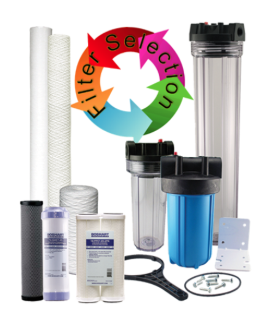
WARNING: Do not use with water that is microbiologically unsafe or of unknown quality, without adequate water treatment for disinfection before or after the filter.
#1 – Have your water tested.
You must ensure your water supply is microbiologically safe for drink and cooking. Testing will also help identify the water quality issues you may have and size of particulate which is in the water. WARNING: Traditional water filters are not water treatment. They will improve the appearance, taste, and odor of your water but they will not make un-safe water safe!
Link to BOSHART knowledge base article which may be of interest:
#2 - Determine the type(s) of filter cartridge(s) required for the water condition / problem.
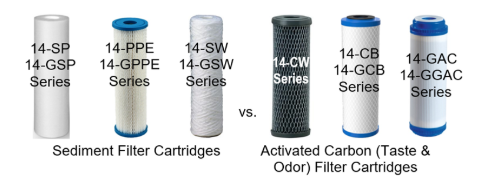
► Sediment / Appearance Issue – Use sediment cartridges -Spun Poly, Pleated or String wound Cartridges
► Taste Issue – Use Activated Carbon Cartridges – Carbon block (CB) , Granular Activated Carbon (GAC) or Powder Activated Carbon Wrapped Cartridges (CW) cartridges
► Odor Issue – Use Activated Carbon Cartridges – Carbon block (CB) , Granular Activated Carbon (GAC) or Powder Activated Carbon Wrapped Cartridges (CW) cartridges
NOTE: Activated carbon cartridges are typically used in Point-of-Use (POU) filtration, however they are also used in point-of-entry (POE) also known as whole-house filtration for some nuisance compounds such as Radon and Volatile Organic Compounds (VOCs). VOCs can easily vaporize from water in showers, washing machines and dishwashers and come in contact with skin.
Link to BOSHART knowledge base article which may be of interest:
#3 - Verify the Desired Flow Rate (GPM)
This the volume of water in gallons per minute that you want to have available when multiple faucets and or appliances are in use. This is critical in the selection process, which brings us to the following question. How do you know how many gallons per minute you need for your home?
A good place to start is to determine how many appliances and faucets you typically would have running at the same time. For example, do you expect that you would run your clothes washing machine, dishwasher and one or two showers at the same time? Also consider if watering of gardens and lawns will increase the demand.
Calculating your GPM instead of your gallons per day usage (Generally speaking each person will use about 75-110 gallons per day). Multiplying this number for each person in the household will give you an estimate of how much water you use in a given day. However, this is not what you use to determine the flow requirement of your filter! The proper way to determine your flow is to calculate your peak flow demand in gallons per minute (GPM). Below is a guide on the GPM range of common appliances and fixtures:
- Dishwasher: 2 to 3 GPM
- Washing machine: 4 to 5 GPM
- Bathtub: 3 to 8 GPM
- Shower: 2 to 5 GPM
- Faucet: 2 to 3 GPM
- Toilet: 2.5 to 5 GPM
If you plan to run all of your appliances, showers and faucets simultaneously, how much would your GPM be? Also take into consideration future requirements such as renovations for an additional bathroom, laundry to your home.
#4 - Select cartridges size
This is done by selecting a cartridge with a suitable GPM (Gallons per minute) flow capacity rating which is significantly higher than what you determined in step number 3.
A rule of thumb is a minimum of 2 times the desired flow. This can vary depending on conditions… For example, 1.5 times maybe sufficient if sediment load is light, but up to 3 times if sediment load is heavy.
WHY? –The published flow rates are based on “CLEAN” cartridge flow rates. To ensure the desired flow to the house is maintained as the cartridge loads with sediment over a period of approximately 6 months. As the cartridge does its intended job removing sediment, it will result in both pressure drop and reduced flow. Therefore, if you start with the flow rate you desire it will quickly start to drop and you will need to replace the filter cartridge before it has removed the maximum sediment load that it is capable of removing and would need to be changed out from a bacterial standpoint. Ideally you want the cartridge to provide sufficient flow for a 4–6-month period, at 6 months the cartridge should be changed to prevent the build up of bacteria.
► Standard 2-1/2” to 2-3/4 Outside Diameter vs. Giant 4-1/2” Outside Diameter
► 10” Nominal Length (Actual length 9-3/4” or 9-7/8” for Spun Poly and String wound) vs. 20” double length cartridges.
NOTE 1: There maybe overlap between 20” Filter Cartridge for a Standard Housing and 10” Filter Cartridge for a Giant Housing, take this into consideration when evaluating your options.
NOTE 2: Normally the water flow entering your home is not the limiting factor for flow. Flow restriction which restricts the GPM to fixtures is due to the piping and filters installed in your home. If you already have a Point of Entry (POE) also referred to as a whole-house filter that traps sediment, which has a cartridge size that cannot support the GPM that your house requires, all you need to do is replace the filter housing with one that uses a larger cartridge that can support a more substantial water flow.
#5 - Select a filter housing to accommodate the cartridge
The housing should never be selected first ! This is one of the most common errors made in selecting a filter system. This results in a situation where you may be limited to using a cartridge which is too small to achieve the GPM rating you require. For this reason, the selection of the filter housing is the last step.
- Type – Slim Line – Standard - Valve-In-Head (VIH) - Giant – Stainless Steel – High Temperature
- Material – Plastic, Plastic with SS thread Inserts or Stainless Steel
- Bowl Material - For Plastic models Clear Filter Bowl (5 Year lifespan) vs. Blue Filter Bowl (10 Year lifespan)
- Line connection size – Giant housing have multiple inlet and outlet connection sizes available.
Guide for filter housing selection:
When it comes to filtration products carried by Boshart Industries we can break them into FOUR basic categories.
#1 – P.O.E. “Point of Entry” a.k.a. Whole House Filtration
NOTE: While P.O.E. Point of Entry / Whole House Filters TYPICALLY use larger 20“ Standard or GIANT filter housings to achieve the desired flow rate, you should not rule out 10” Standard Housings if they can meet the flow demand for low occupancy dwellings.

NOTE: Typically spun-poly, string wound or pleated sediment cartridges are used in Point-of-Entry (POE) filtration to remove particulate.

In some situations, activated carbon cartridges may be required for POE filtration to remove nasty odors from the water for washing and showers, activated carbon also is used for nuisance compounds such as Radon and Volatile Organic Compounds (VOCs). VOCs can easily vaporize from water in showers, washing machines and dishwashers and come in contact with skin.

Consider adding second P.O.E. Pre-Filter SPIN-OUT type Sediment / Sand Separator Filter plumbed in series ahead of the whole house sediment filter when the sediment load is extreme!
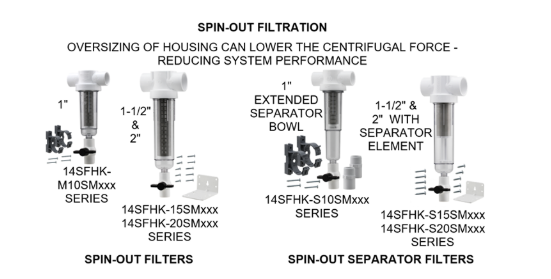
Link to BOSHART knowledge base articles which may be of interest:
https://support.boshart.com/what-mesh-rating-do-i-need-for-my-spin-out-filter-or-separator-filter
https://blog.boshart.com/spin-out-filters-and-separators-webinar
#2 – P.O.U. “Point of Use” Filtration
Activated Carbon filter cartridges are most commonly installed in Point-of-Use (POU) filters, typically a 10” filter housing is used, the Slim-Line filter housing kits are ideal for POU applications, in cases where the space is extremely limited, a 5” housing may be required. The 5” housings are commonly used in Camping trailers, RV;s and Boats where there is not enough room for a standard 10” housing.
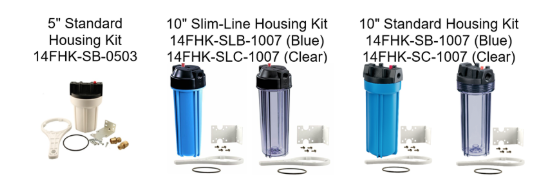
Below are 5 types of activated carbon filter cartridges commonly used for POU filtration.
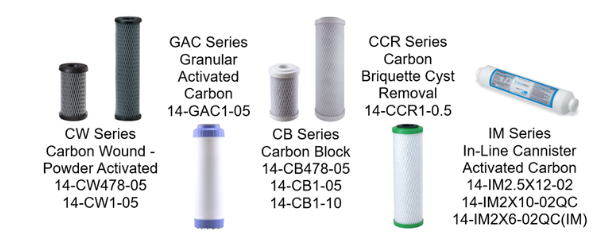
#3 – Pre and Post Filtration
Boshart does not carry Water Treatment / Water Purification Filtrations Systems such as R.O. (Reverse Osmosis) or U.V. (Ultraviolet) Filters. However, all water treatment filtrations systems require “PRE” & “POST” filtration. We do carry both the filter housing & cartridges which are used for pre and post filtration in these systems.
Reverse Osmosis (RO)
- Sediment Cartridges to Remove… Sand – Silt – Dirt Typically 1–5-micron ratings
- Carbon Cartridges to Remove Chlorine which can damage the RO membranes. 0.5-to-5-micron ratings
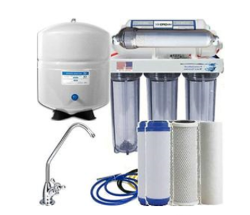
Ultraviolet (UV)
- Sediment Cartridges to Remove… Sand – Silt – Dirt Typically 1–5-micron ratings IMPORTANT: Water must be filtered to 5 Microns or LESS for UV filter to work! Always follow the instructions from the manufacturer of the UV system.
- Carbon Cartridges are used to remove chlorine which can damage the expensive RO membranes cartridges. Typically, 0.5-to-5-micron ratings.
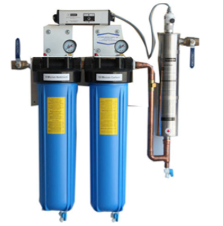
#4 – Special Applications
- HIGH Temperature.
- High Pressure
- Chemical Compatibility

